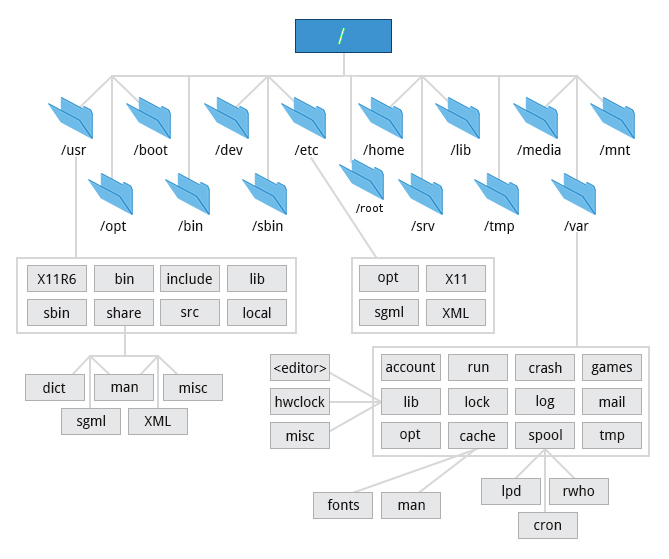FHS¶
whereis -m hier
man hier

Here, only the most important directories in the system will be presented.
/bin is a place for most commonly used terminal commands, like ls, mount, rm, etc.
/boot contains files needed to start up the system, including the Linux kernel, a RAM disk image and bootloader configuration files.
/dev contains all device files, which are not regular files but instead refer to various hardware devices on the system, including hard drives.
/etc contains system-global configuration files, which affect the system's behavior for all users.
/home home sweet home, this is the place for users' home directories.
/lib contains very important dynamic libraries and kernel modules
/media is intended as a mount point for external devices, such as hard drives or removable media (floppies, CDs, DVDs).
/mnt is also a place for mount points, but dedicated specifically to "temporarily mounted" devices, such as network filesystems.
/opt can be used to store additional software for your system, which is not handled by the package manager.
/proc is a virtual filesystem that provides a mechanism for kernel to send information to processes.
/root is the superuser's home directory, not in /home/ to allow for booting the system even if /home/ is not available.
/run is a tmpfs (temporary file system) available early in the boot process where ephemeral run-time data is stored. Files under this directory are removed or truncated at the beginning of the boot process. (It deprecates various legacy locations such as /var/run, /var/lock, /lib/init/rw in otherwise non-ephemeral directory trees as well as /dev/.* and /dev/shm which are not device files.)
/sbin contains important administrative commands that should generally only be employed by the superuser.
/srv can contain data directories of services such as HTTP (/srv/www/) or FTP.
/sys is a virtual filesystem that can be accessed to set or obtain information about the kernel's view of the system.
/tmp is a place for temporary files used by applications.
/usr contains the majority of user utilities and applications, and partly replicates the root directory structure, containing for instance, among others, /usr/bin/ and /usr/lib.
/var is dedicated to variable data, such as logs, databases, websites, and temporary spool (e-mail etc.) files that persist from one boot to the next. A notable directory it contains is /var/log where system log files are kept.
Binary Paths:¶
Please refer to the Filesystem Hierarchy Standard (FHS) for Linux for this.
/bin : For binaries usable before the /usr partition is mounted. This is used for trivial binaries used in the very early boot stage or ones that you need to have available in booting single-user mode.
Think of binaries like cat, ls, etc.
/sbin : Same, but for scripts with superuser (root) privileges required.
/usr/bin : Same as first, but for general system-wide binaries.
/usr/sbin : Same as above, but for scripts with superuser (root) privileges required.
if I'm writing my own scripts, where should I add these?¶
For system-wide available scripts:
- You should use /usr/local/bin or /usr/local/sbin
- The local path means it's not managed by the system packages. (ex: make install).
For user-scoped scripts:
use ~/bin (a personal bin folder in your home directory).
The FHS says for /usr/local:
Tertiary hierarchy for local data, specific to this host. Typically has further subdirectories, e.g., bin/, lib/, share/.
Lecture notes¶
- All lecture notes are available at github in
ipynbformat: https://github.com/ravexina/linux-notes.
- There are
htmlexports of project available at: https://ravexina.github.io/linux-notes.
License¶
Linux Notes by Milad As (Ravexina) is licensed under a Creative Commons Attribution-NonCommercial-ShareAlike 4.0 International License.


